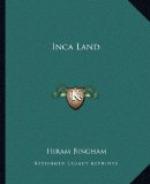The other temple is on the east side of the pampa. I called it the Temple of the Three Windows. Like its neighbor, it is unique among Inca ruins. Its eastern wall, overlooking the citadel, is a massive stone framework for three conspicuously large windows, obviously too large to serve any useful purpose, yet most beautifully made with the greatest care and solidity. This was clearly a ceremonial edifice of peculiar significance. Nowhere else in Peru, so far as I know, is there a similar structure conspicuous as “a masonry wall with three windows.”
These ruins have no other name than that of the mountain on the slopes of which they are located. Had this place been occupied uninterruptedly, like Cuzco and Ollantaytambo, Machu Picchu would have retained its ancient name, but during the centuries when it was abandoned, its name was lost. Examination showed that it was essentially a fortified place, a remote fastness protected by natural bulwarks, of which man took advantage to create the most impregnable stronghold in the Andes. Our subsequent excavations and the clearing made in 1912, to be described in a subsequent volume, has shown that this was the chief place in Uilcapampa.
It did not take an expert to realize, from the glimpse of Machu Picchu on that rainy day in July, 1911, when Sergeant Carrasco and I first saw it, that here were most extraordinary and interesting ruins. Although the ridge had been partly cleared by the Indians for their fields of maize, so much of it was still underneath a thick jungle growth—some walls were actually supporting trees ten and twelve inches in diameter—that it was impossible to determine just what would be found here. As soon as I could get hold of Mr. Tucker, who was assisting Mr. Hendriksen, and Mr. Lanius, who had gone down the Urubamba with Dr. Bowman, I asked them to make a map of the ruins. I knew it would be a difficult undertaking and that it was essential for Mr. Tucker to join me in Arequipa not later than the first of October for the ascent of Coropuna. With the hearty aid of Richarte and Alvarez, the surveyors did better than I expected. In the ten days while they were at the ruins they were able to secure data from which Mr. Tucker afterwards prepared a map which told better than could any words of mine the importance of this site and the necessity for further investigation.
With the possible exception of one mining prospector, no one in Cuzco had seen the ruins of Machu Picchu or appreciated their importance. No one had any realization of what an extraordinary place lay on top of the ridge. It had never been visited by any of the planters of the lower Urubamba Valley who annually passed over the road which winds through the canyon two thousand feet below.




